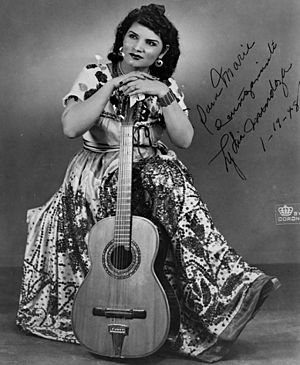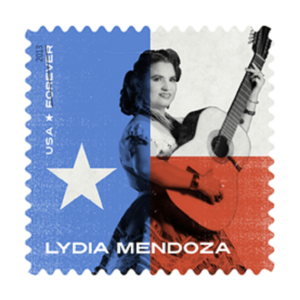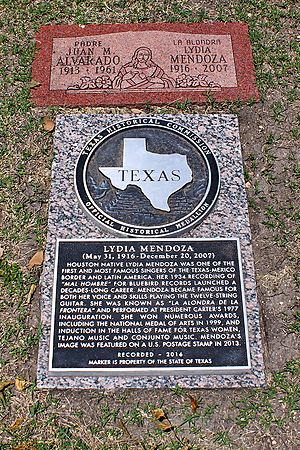Lydia Mendoza facts for kids
Quick facts for kids
Lydia Mendoza
|
|
|---|---|
 |
|
| Background information | |
| Born | May 31, 1916 Houston, Texas, U.S. |
| Died | December 20, 2007 (aged 91) San Antonio, Texas, U.S. |
| Genres |
|
| Occupation(s) |
|
| Instruments | Twelve-string guitar |
| Years active | 1928–1998 |
Lydia Mendoza (born May 31, 1916, died December 20, 2007) was an amazing Mexican-American guitarist and singer. She was famous for her Tejano and traditional Mexican-American songs. Many people called her "The Mother of Tejano Music." This special music style from Texas mixes Mexican, Spanish, German, and Czech sounds.
Lydia sang and played for over 60 years! She recorded about 200 different Spanish songs on more than 50 albums. In 1977, she even performed for President Jimmy Carter at his inauguration. Her most famous song was "Mal Hombre," which means "Bad Man." She had known this song since she was a child.
Lydia was born in Houston, Texas. Her family was musical and originally from San Luis Potosí, Mexico. They moved to Texas because of the Mexican Revolution. Even though she lived most of her life in Texas, she always spoke Spanish. Her family moved often to find work. They would entertain other migrant workers wherever they went.
People gave Lydia many nicknames, like "La Alondra de la Frontera" (The Meadowlark of the Border). When she was young, her family, called "La Familia Mendoza," would hitchhike around south Texas. They performed for farm workers. When Lydia was only 12, her family recorded their first songs for Okeh Records. Lydia sang and played the mandolin. Later, they signed a contract with RCA Victor. During World War II, Lydia and her sisters performed as Las Hermanas Mendoza (the Mendoza sisters). Lydia became the main singer, but her family often performed with her. She toured all over the United States, Canada, and Latin America.
Lydia Mendoza received many awards for her music. She got a National Heritage Fellowship and was inducted into the Tejano Music Hall of Fame. In 1999, she received the National Medal of Arts from President Bill Clinton and First Lady Hillary Clinton. Lydia even designed and sewed her own stage costumes! She was married twice and had three daughters. She retired from performing a couple of times but always came back to singing. A stroke in her 80s finally made her stop performing for good.
Contents
Early Life and Family
Lydia Mendoza was born on May 31, 1916, in Houston, Texas. Her parents, Leonor and Francisco Mendoza, were musicians from San Luis Potosí, Mexico. They moved to Texas in 1910 because of the Mexican Revolution.
The Mendoza family had eight children. Lydia and her older sister Beatriz were born in Texas. The family moved back to Mexico for a short time, where two more children were born. Then they returned to Texas. The family formed a music group called "La Familia Mendoza."
When Lydia was a toddler, her family faced difficulties when crossing the border back into Texas. Immigration agents would treat Mexican people poorly, sometimes using gasoline to prevent lice. Lydia remembered seeing children being washed with gasoline. She felt the agents thought everyone from Mexico was "bad."
Learning Music
Lydia was very young when she started copying her mother and grandmother's singing. This is how she first learned "Mal Hombre" (Bad Man), which became her most famous song. She once said she saw the words to the song on a gum wrapper. Later, she saw it performed as a tango in Mexico. She memorized the song and practiced it a lot.
Lydia knew from age four that she wanted to be a musician. Her mother, father, and grandmother taught her how to sing and play string instruments. Her grandmother, Teofina Reyna, even taught Lydia's mother to play guitar. Lydia loved the guitar and would try to play her mother's instrument, even when told not to.
Her mother eventually hung the guitar out of reach. But Lydia was determined! She made her own instrument using rubber bands. After a few years, her mother gave in and taught her to play a six-string guitar. Lydia also learned the mandolin and violin. Her father taught her to play 12-string guitars, like the Bajo sexto.
Performing for Migrant Workers
Before Lydia could play instruments, her family was already entertaining farm workers. Her father worked for the railroad, and the family sang for migrant workers in the fields. They couldn't afford a car, so they often hitchhiked. They moved around a lot, so the children didn't go to school much, but they learned at home.
In 1928, the family saw an advertisement in a Spanish newspaper. OKeh Records wanted to record new Spanish-speaking artists. The family borrowed a car and went to San Antonio. They made their first recordings as the Cuarteto Monterrey por la Familia Mendoza. Twelve-year-old Lydia sang and played the mandolin. They earned $140 for their work.
In 1929, the Mendozas moved to Detroit, Michigan, to work on farms and in car factories. Many Mexican workers were moving north for jobs, so the Mendoza family found many people who loved their music. They performed in Michigan before returning to San Antonio, Texas, in 1932, during the Great Depression in the United States. During World War II, Lydia's sisters, Juanita and Maria, performed as Las Hermanas Mendoza. Their earnings helped the family buy their first home. Lydia later joined them as a soloist. The trio toured until 1952, when their mother passed away.
Success with Bluebird Records
The family found many fans among the Mexican farmworkers in San Antonio. Lydia started playing the 12-string guitar instead of the mandolin. Their main audience was the working-class Tejano people in the city. They didn't earn a lot of money, but they always had a home and food.
When Lydia was a teenager, she performed at a park in San Antonio. Manuel J. Cortez, a radio host, discovered her. He gave her a spot on his radio show, where she won a competition. She earned $3.50 a week and signed with Bluebird Records, which was part of RCA Victor. In 1937, she recorded her famous song "Mal Hombre." It became a huge hit in both the United States and Mexico.
Lydia never learned English and didn't have a lawyer. She signed a contract that gave up her rights to future payments for her songs. Instead, she received a one-time payment of $15 for each recording.
Lydia's music was very popular with the Tejano community. She became the star of the Mendoza family's musical group. They performed in Spanish-speaking areas along the border, from Texas to California. Her music helped people feel proud of their heritage. However, people of color still faced discrimination in hotels and restaurants during that time. Despite this, the family continued to perform and was very popular.
Later Years and Retirement
For many years, the Mendoza family performed across the United States and Latin America. In 1971, Lydia performed at the Smithsonian Festival of American Folklife in Canada. She also taught at California State University, Fresno for a while. In 1977, she performed at President Jimmy Carter's inauguration.
Personal Life
Lydia married Juan Alvarado in 1935 and had three daughters: Lydia, Yolanda, and María Leonor. She stopped performing for a time to raise her children. Her husband's family didn't like her job, or perhaps thought women shouldn't work. But Lydia earned more money, so she eventually went back to touring. Her first marriage lasted until her husband's death in 1961. She retired again but then remarried in the early 1960s to Fred Martínez.
Lydia designed and sewed her own stage costumes throughout her career. Her popularity stayed strong until 1998, when a stroke at age 82 forced her to stop performing for good.
Even though she was born in Texas and lived most of her life in the United States, Lydia never learned to speak English. She passed away on December 20, 2007, at 91 years old. She is buried in San Antonio, Texas. A special marker was placed at her grave in 2016 to honor her.
Legacy and Awards
People gave Lydia Mendoza many loving nicknames. They called her "La Alondra de la Frontera" ("The Meadowlark of the Border") or "The Lark of the Border." She was also known as "La Cancionera de los Pobres" ("The Songstress of the Poor") and "La Gloria de Texas" ("The Glory of Texas"). Historian Michael Joseph Corcoran called her "The Mother of Tejano Music."
"Tejanos" refers to Texans of Mexican heritage. Tejano music mixes traditional Mexican-Spanish, German, and Czech sounds. This music style grew popular in the early 1900s along the Texas-Mexico border. Lydia's group also helped make "conjunto" music popular, which is a style centered around the accordion. In 1984, she joined the Tejano Music Hall of Fame. In 1991, she was inducted into the Conjunto Music Hall of Fame.
In 1982, Lydia was one of the first people to receive a National Heritage Fellowship from the National Endowment for the Arts. This is the highest honor the U.S. government gives for folk and traditional arts. It celebrates artists who help keep American culture alive. Lydia was the first Texan to receive this award.
She was also inducted into the Texas Women's Hall of Fame in 1985 for her contributions to the performing arts. In 1999, she received the National Medal of Arts from President Bill Clinton and First Lady Hillary Clinton at the White House. In 2001, she received a Lifetime Achievement Award. In 2003, she was given the Texas Medal of Arts.
In 2013, the United States Postal Service released a Lydia Mendoza postage stamp. It was the first stamp in their Music Icon series.
Select Recordings
Lydia Mendoza recorded Spanish songs for over 60 years. She made about 200 different songs on at least 50 albums. Some of the record labels she worked with include RCA Records, Columbia Records, and Discos Falcon.
Here are some of her early recordings with her family:
- Recorded March 8, 1928
- "Julia"
- "Monterrey"
- "Canción de amor"
- "Amorcito consentido"
- "Las cuatro milpas"
- "El tecotote de Guadena"
- Recorded March 10, 1928
- "Delgadina"
- "No quiero ser casado"
- "A mi Juana"
- "En el rancho grande"
- "El hijo pródigo"
- Bluebird Records – the Texas Hotel in San Antonio
- Recorded March 27, 1934
- Cuarteto Monterrey por la Familia Mendoza musical group, with Lydia as a vocalist and violinist
- "Ojitos de mi chata"
- "Por tus amores"
- "Ojitos negros y chinos"
- "La china"
- "Para que necesitas a mi amor"
- "Castos sueños"
- Vocal solo, with guitar
- "Mal hombre" (she also wrote this song)
- "Al pié de tu reja"
- "No puedo dejar de quererte"
- "Lejos"
- "La última copa"
- "Lamento borincano"
- Recorded August 10, 1934
- Vocal solo, with guitar
- "Sigue adelante"
- "Lidya"
- "Viviré para ti"
- "Pero hay que triste"
- "Los besos de mi negra"
- "Mundo engañoso"
- Lidya Mendoza y Cuarteto Mendoza, vocal and instrumental quartet
- "No me anuncies"
- "Toma este puñal"
- "China de los ojos negros"
- "Si estás dormida"
- "María, María"
- "Una rancherita"
- Recorded January 31, 1935
- Solo with guitar
- "Siempre te vás"
- "La mujer del puerto" (playing both guitar and mandolin)
- "As de corazones"
- "La cumbancha"
- "Temo"
- "La casteñita"
- "El lirio"
- "Deliciosa"
- Recorded February 1, 1935
- Lidya Mendoza y Familia, quartet leader, vocal and instrumental
- "Panchita" (she also wrote this song)
- "El muchacho alegre"
- "Traje mi caballo prieto"
- "Díos vendiga" (she also wrote this song)
See also
 In Spanish: Lydia Mendoza para niños
In Spanish: Lydia Mendoza para niños



